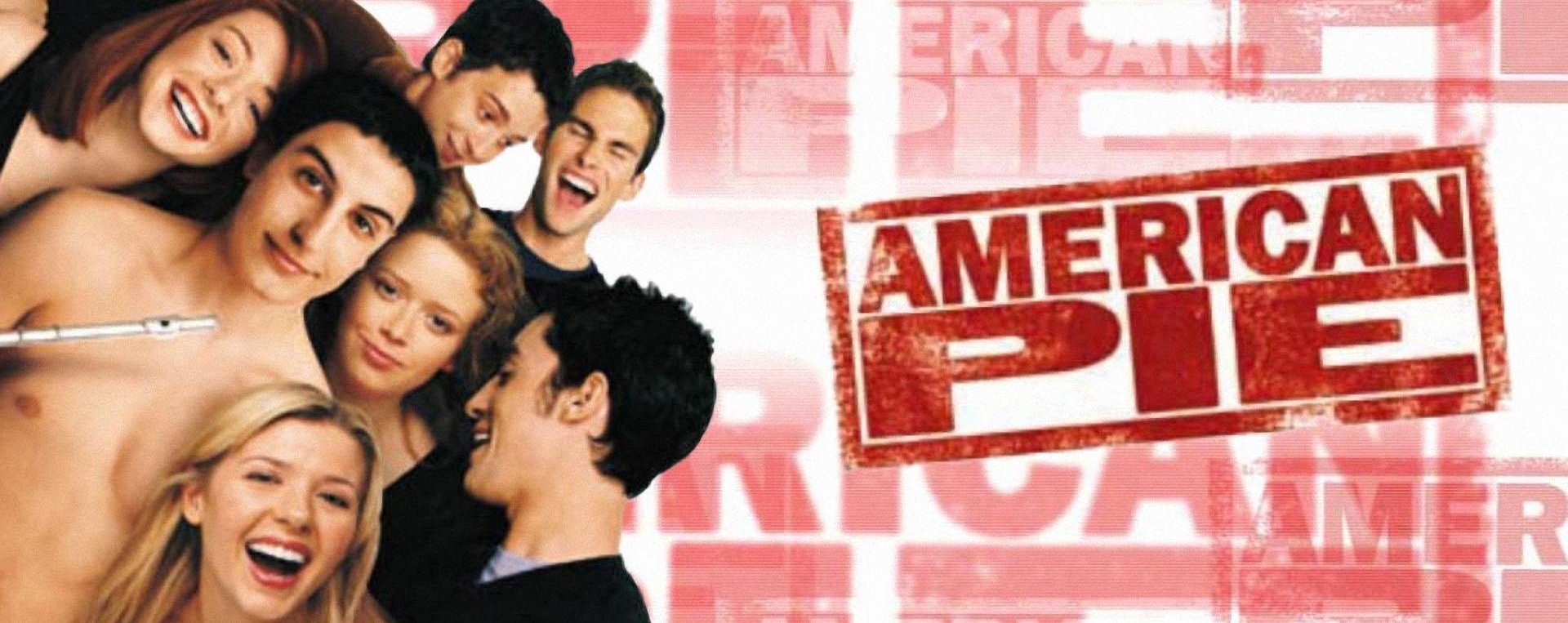"American Pie" Computer/Video Displays Designed By: Banned From the Ranch Entertainment Written by James Monohan
THE CHALLENGE
The production team behind the comedy "American Pie" commissioned Banned From the Ranch Entertainment to create the film's computer graphics and video displays. BFTR is known for its excellent track record, having built computer displays for such big budget films as "Starship Troopers," "The Relic" and "Twister." Todd Vaziri, BFTR's lead visual effects artist and graphics supervisor for Jennifer Lopez's "If You Had My Love" video, helmed the "American Pie" project. Vaziri and his team were responsible for creating the films' computer and video displays and solving issues related to 24 fps (frames per second) playback and camera synchronization. What made "American Pie" different was that it had a substantially lower budget and an emphasis on realism as opposed to fantasy.
Todd Vaziri explained the particular challenge on the film: "Since we usually work on big budget sci-fi movies, we're used to creating stylized interfaces that don't have to look realistic. For 'Pie,' the director (Paul Weitz) and the producers were looking for computer systems that could be found in somebody's home. We wanted to avoid the trap into which other films fall when they are too fanciful about portraying modern technology. For example, at this point in Internet technology, you can't select a video on the World Wide Web and see full screen video at 30 fps. In this film, the intention was to keep it very honest."
The first scene assigned to Vaziri and his crew was the opening of the film, in which one of the protagonists (Jim) becomes aroused by watching scrambled pornography on TV. BFTR's task was to create the scrambled porn clip from a provided videotape. "They handed us a very explicit hardcore tape that we had to edit," Vaziri recalled. "We needed to scramble the footage while keeping some of its images recognizable. For instance, there's actually a line in the movie when Jim says 'Yes, I saw a tit!' At that moment, we needed to show a breast through the scrambling."
The second scene assigned to BFTR involved Jim using his QuickCam to send his image to an email dating service. "We needed the E-Date page to be realistic, yet instantly recognizable," Vaziri said. "In order for the camera to pick up all the necessary information, the graphics couldn't be too small nor the text too tiny. An added challenge was that we couldn't use a real Web browser due to licensing issues. However, we had the cooperation of Apple, so we were allowed to create a Macintosh-style interface."
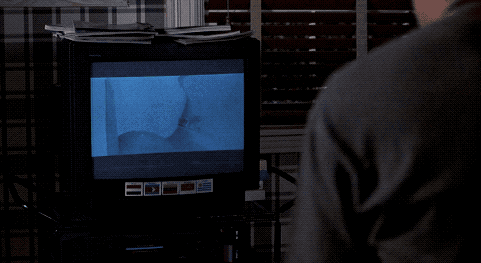
The third scene assigned to the graphics company presented an even greater challenge. The scene involved Jim again using his computer's QuickCam. In this case, he set up a live Webcast of his encounter with a beautiful woman (Nadia). The scene was intercut with shots of other characters watching the images on their own desktops. "The problem," Vaziri noted, "was to create a QuickTime movie that was as large as possible, without becoming completely unrealistic. In addition, we needed to combine the QuickCam image of Jim setting up his camera (which was recorded live, as it happened on the set) with the QuickCam of image of Jim and Nadia cavorting (which was not recorded live)." The fourth and final scene requiring a computer display was difficult mainly because it involved a last minute change in the script: "The filmmakers altered the ending as they were filming," Vaziri remembered. "They came to us with the new concept of Nadia and Jim communicating from different locations using their QuickCams. We had to create this part in a very short time frame."
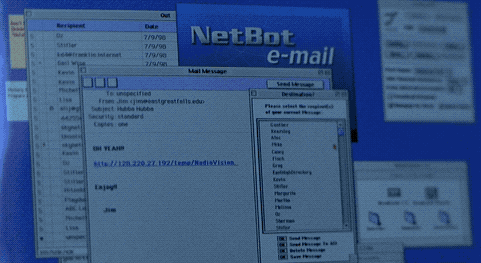
THE STRATEGY For Vaziri and his team, pre-production involved a large amount of visualization and testing: "I went through the script and storyboarded what I would create. For the computer scenes," Vaziri said, "I made sample desktops, printed them out, and had the directors look over them. The quality of the live video image was discussed, since there were many issues concerning the appropriate frame rate and strobing needed to achieve the appropriate look and feel. We eventually decided to use between 5 and 10 fps." Vaziri put careful consideration into ensuring that each desktop seen in the movie reflected the personality of the user. For example, Jim's desktop included a signpost that read "Possible ways to get laid" and an email which read, "Jim, I really like you. I think you're a nice guy. But you're a little creepy for me..." The desktop of a computer used by a teenage band, on the other hand, involved a marijuana leaf pattern. It was decided that BFTR would shoot the QuickCam footage on the set, simultaneous with motion picture filming. "We couldn't rely on the actual QuickCam because the image quality wouldn't be right for our purposes," Vaziri said. "We set up a BetaCam at the approximate place where the QuickCam would be, and the entire scene was shot without interruption to ensure continuity. For the master shot, we did three takes in two sections. It turned out to be a lot of footage." The porn scrambling, desktop design and QuickCam video creation were all accomplished in-house at Banned From The Ranch. The team used Macromedia Director, Adobe Photoshop, Adobe After Effects, QuickTime and Adobe Premiere on a G3 computer. The on-set image manipulation was accomplished using a Silicon Graphics INDY machine, which involved a presentation program custom built by Silicon Graphics for a previous Banned From the Ranch project. THE PRODUCTION The first assignment, to create a scrambled pornographic movie, was accomplished by Todd Vaziri and his team after some experimentation. "First, we tried to distort the image digitally in After Effects," Vaziri notes. "However, the result didn't feel analog enough. Glen Cannon, our technical supervisor, ran the signal through a series of scramblers and converters. That achieved the look we needed, including the clip's monochromatic hue. We then took that clip, which lasted three minutes, and looped it several times on the tape. This saved time on set because we didn't have to keep cueing the clip." For the scene in which Jim posts his image on an internet dating service, Vaziri created the entire desktop of Jim's computer. "I made a fictional browser called NetBot," he recalled. "Then, with the E-Date page, I used red hearts and large lettering to ensure the audience immediately comprehended the Web page. The 'snapshot' feature on the Macintosh computer was very helpful because it allowed me to control what was seen on the computer during the scene. 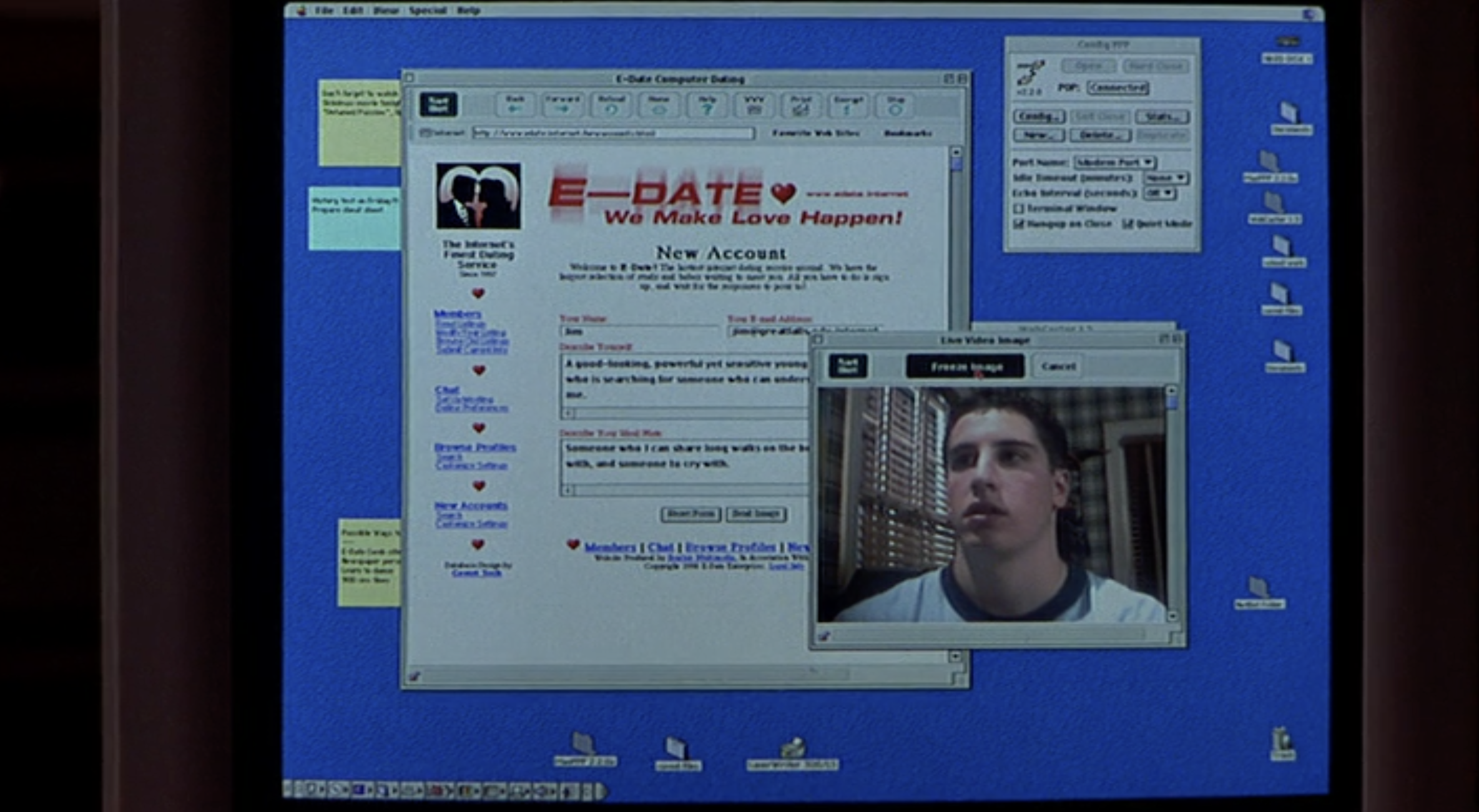
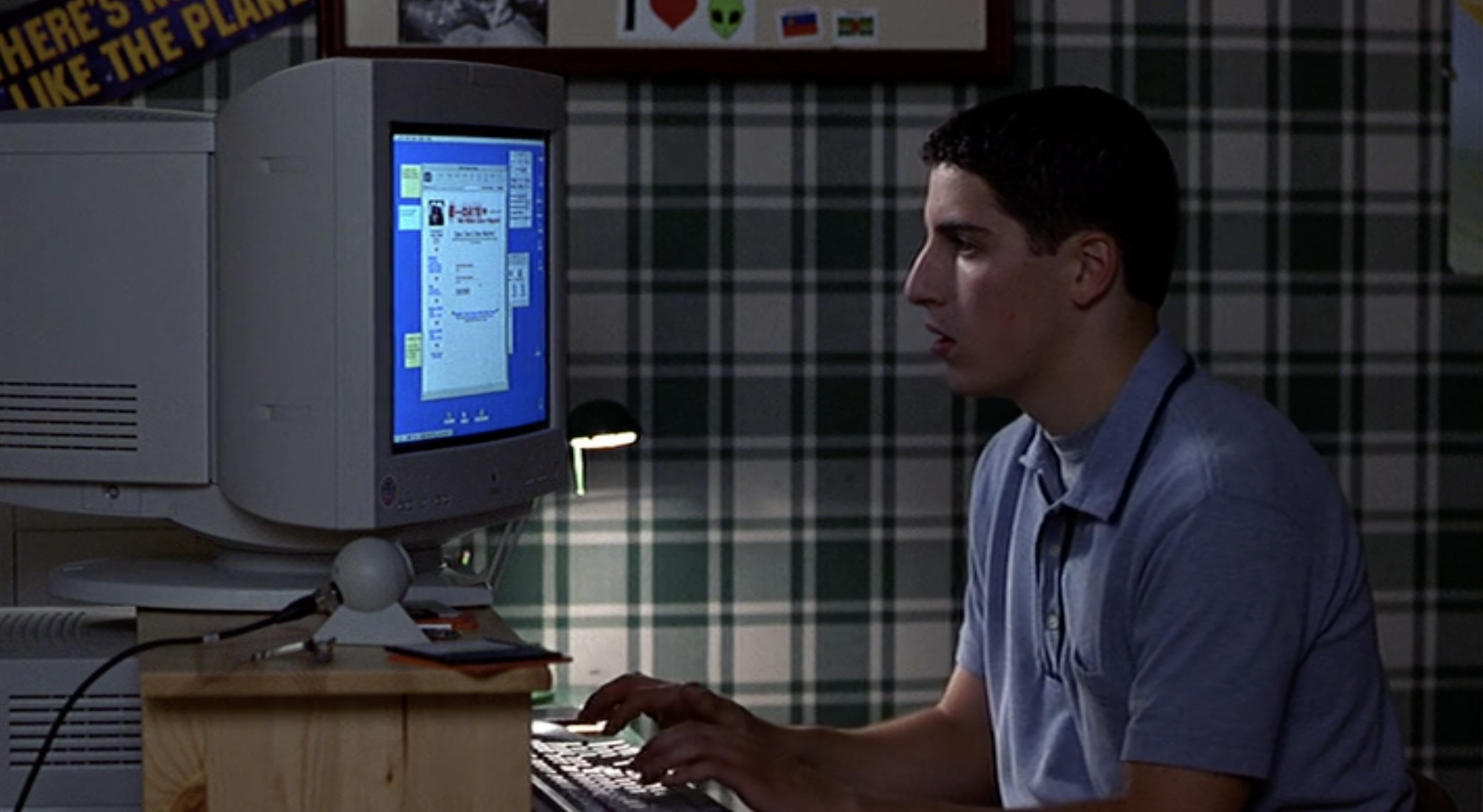
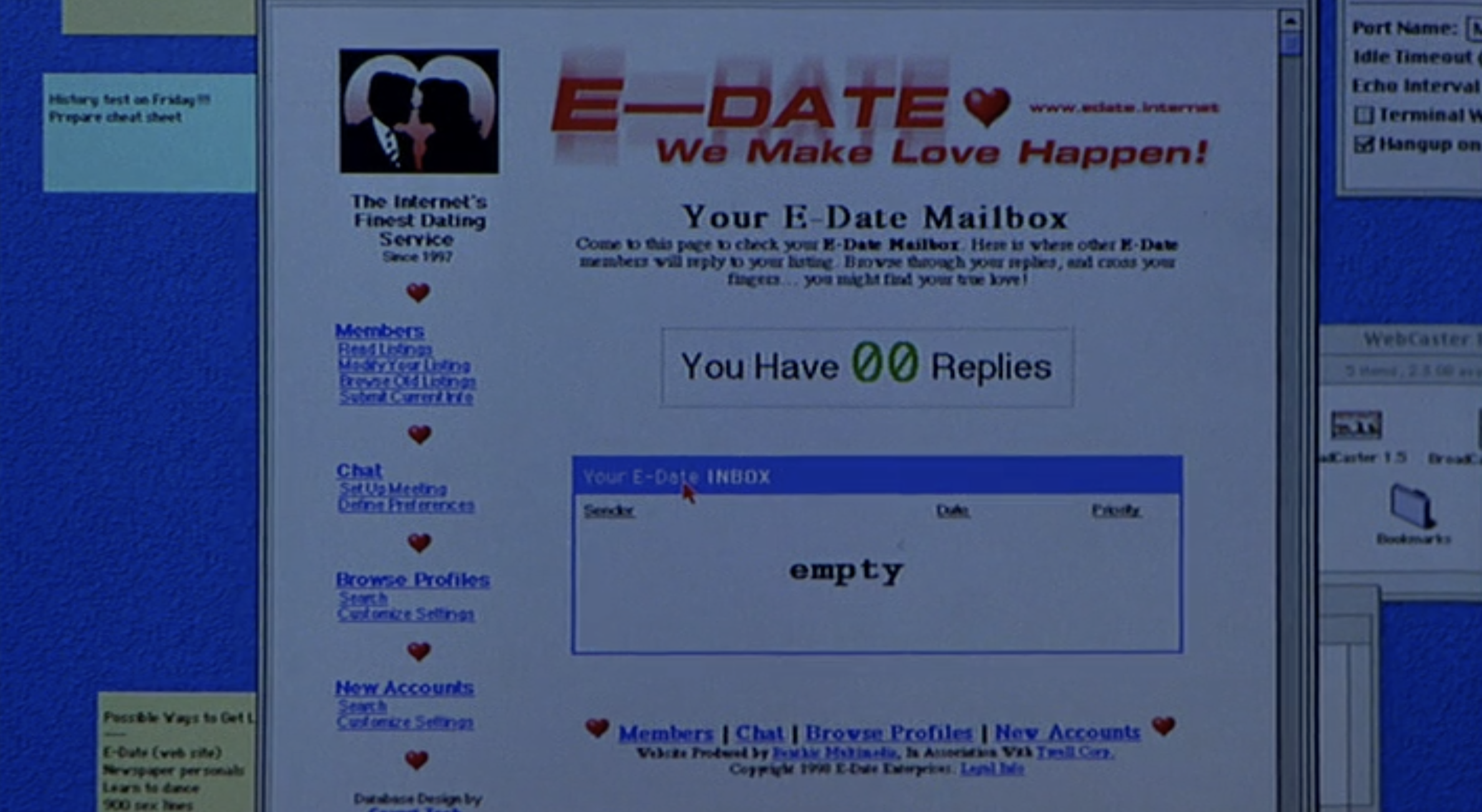
As anticipated, the scene in which Jim Webcasts his exploits with Nadia presented the most hurdles. "Rigging our equipment on the set was a wiring nightmare," Vaziri remembered. "The computer on Jim's desk was merely a prop. Everything was actually running off a UNIX box. The QuickCam was wired through the UNIX box out to the computer. During each take I would hide behind the desk, just out of camera range so I could quickly reset the QuickCam. Then, for the footage of Nadia and Jim, we shot simultaneously with the motion picture filming. Since it was a closed set, our Betacam had to be operated remotely from a different room." Banned From the Ranch was given two weeks time to process all the footage and create the desktops on which the clips would appear. According to Vaziri, part of this time was spent hiding some of the film equipment: "During the scene between Nadia and Jim, the boom mike kept popping into the video frame. In After Effects, I had to digitally remove the boom as well as some of the set rigging. Later, I also used After Effects to meld the QuickTime footage of Jim positioning the QuickCam with the BetaCam footage we shot. The BetaCam footage was spliced in during the whip pan to Jim's bed."
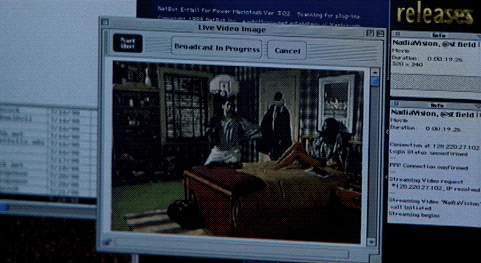
After filmmaking, the task was to capture and manipulate thirty minutes of Betacam footage from the Nadia scene. According to Vaziri, Adobe Premiere was very important during this stage. "We transferred the footage to 8mm using a portable player," Vaziri recalled. "Then, I digitized the footage into Premiere which was a fantastic way to capture it. These were eight to ten minute takes and they had to be flawless capture. There were no problems using Premiere. It was all very inuitive. The options in Premiere's capture window allowed me to experiment with a couple of different codecs (compression/decompression rates) as well as frame rates. I knew that the target frame rate would be 5 fps, but I ended up capturing it at eight fps at 400x375 pixels. I used MJPEG codec for the import. " To render and export the footage, Vaziri used Premiere's CD-Rom Moviemaker function. "The CD-ROM movie maker function in Premiere is obviously intended for CD-ROMs. However, I used it to make a playback QuickTime that could play off of a hard drive. That came through for me with flying colors. With that CD-ROM function, Premiere allowed me to specify codec, data rate and frames-per-second. The codec for this playback was Cinepak."
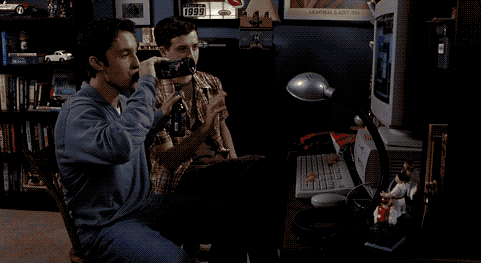
Vaziri also relied on Premiere for file managing. "I used Premiere to manage very long QuickTime sections," he said. "Sometimes we had to break down the clips into sections the editors wanted for each scene. With Premiere, we could go to the Timeline and choose the in and out points on the precise time code numbers that were requested. Then, we were able to render out the section we needed." Vaziri created computer displays which were believable, yet entertaining. "I pushed the boundaries of realism," Vaziri said. "The Webcast image turned out to be 400 x 375 running at 5 fps. That's a sizeable image for your average modem. However, the image was pixelated and the frame rate was jerky enough to be convincing."
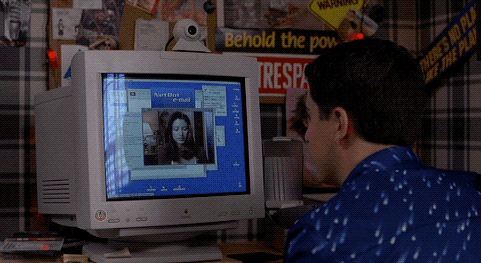
As for the final scene, in which Jim dances for Nadia over the Web, things were done differently by Vaziri since the time frame was tighter. Since his team didn't have the luxury to fully process the footage, the shots of Nadia at her computer were simply strobed at 10 fps using the SGI's video capabilities. "If you look very carefully during that final scene," Vaziri said, "you can see the interface is actually an SGI window, not a Macintosh. However, the vast majority of people who see the film aren't going to notice." In the end, Banned From the Ranch achieved their primary goal: realism. According to Vaziri, "The results were as seamless as possible."
Client: "American Pie" (Universal Pictures)
Design Company: Banned From the Ranch Entertainment
Tools: |
